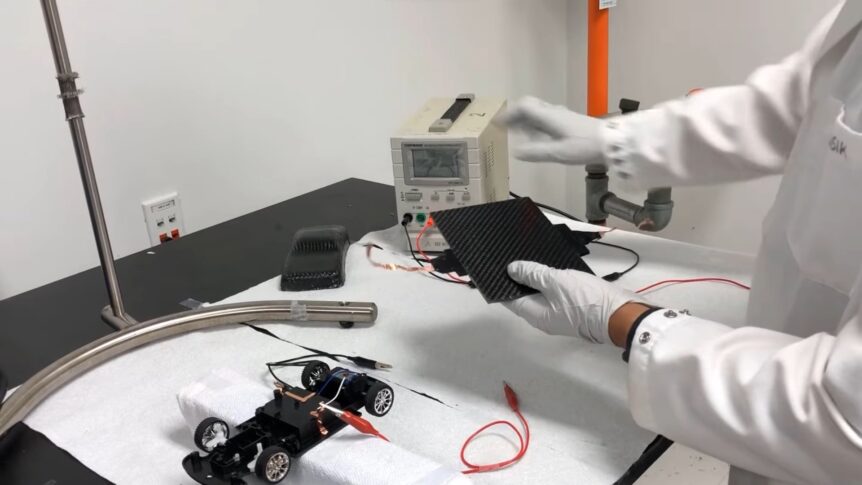Is it possible to combine the best features of batteries and supercapacitors to get both enduring energy storage and bursts of power? Batteries, to varying degrees can store energy and release it over time. Supercapacitors can provide instant, but short-lived power. Even more challenging, can can we form a hybrid structural battery, combining form with function? University of Central Florida researchers think they’ve answered those questions with a battery-supercapacitor hybrid material that could form “power suits” for electric vehicles. Improving on an Earlier Idea This blog first reported on structural batteries 12 years ago, examining the efforts of Volvo and Dr. Emile Greenhalgh of Imperial College London. Several approaches have been made to create a structural battery, but the “power suit” combines electrical potency with enough structural strength to resist driving impacts. UCF reports, “This new breakthrough continues this line of thinking, with scientists at University of Central Florida and NASA designing a new material featuring unique properties that allow for …
APUS Introduces Two Zero Emission Craft
We’ve written several times about structural batteries in this blog, from Dr. Emile Greenhalgh’s early research at Imperial College to more recent efforts along the same line. Interestingly, the basic idea remains very much the same over a decade. Energy storage would take place in a monocoque-type structure that could use carbon fiber, fiberglass, and even graphene as a structural material, while acting as a battery. Now some of this thinking is being applied to hydrogen storage in wings. “TubeStruct™” APUS, an aircraft design, structure and certification operation in Strausberg, Germany, offering a full range of services including flight training. They recently announced two new craft, both featuring hydrogen fuel systems contained in a novel “… patented structurally integrated hydrogen storage system, known as TubeStruct™.” In the shadow drawings of the airplanes, the tubes appear as though they could double as redundant wing spars. The i-2, a four-seat Normal-Category (CS-23) aircraft; and “The APUS i-6 is a technology demonstration platform …
Conventional Batteries “A Thing of the Past?”
Volvo Car Group has announced their development of what they term, “A revolutionary concept for lightweight structural energy storage components that could improve the energy usage of future electrified vehicles.” Using carbon fiber and other composite materials to make batteries and supercapacitors within structural panels, Volvo hopes to offer “lighter energy storage that requires less space in the car, cost effective structure options and is eco-friendly.” This blog reported on earlier efforts by Dr. Emile Greenhalgh at Imperial College in London, working on creating energy storage with simple carbon-fiber/fiberglass/carbon-fiber sandwiches as an academic lead partner with Volvo. His work is directed toward creating structural supercapacitors, while efforts at Volvo in Sweden, led by Per-Ivar Sellergren and working with his nearly two-decade-old patents, are aimed toward crafting lightweight batteries to replace metal structures. Funded as part of a European Union research project, and concerned with improving energy storage, the effort has Volvo as its only car manufacturer. The car maker’s project …
Running a Mile in Very New Shoes
The Lola-Drayson LeMans Prototype (LMP) did not make it to this year’s LeMans race at the Sarthe track, but did make its racing debut at another prestigious motorsports event – the Goodwood Festival of Speed Hill Climb in England. Nowhere near as long or treacherous as America’s Pikes Peak event, the race is a good test of acceleration, handling and sheer power, which the car displayed with great style. http://www.youtube.com/watch?v=sd-vAq4IDRA Lord Paul Drayson, a former science advisor to the Crown, drove the B12/69EV, a car crammed with new technologies, many of which have been reported on in this blog, and which have potential applications in aircraft. He also set a new record for electric cars in the climb, doing a timed run of 53.91 seconds and placing 11th overall in the July 1 run. Goodwood’s hill climb is only 1.86 kilometers (1.16 miles) with a mere 9 turns, and the fastest official time up the slope was the 1999 McLaren …
Structures as Batteries – or Is It Batteries as Structures?
Imperial College London and its partners, including Volvo, have announced a £3.4 million (about $5.44 million) project to develop a new energy storage material that could act as a structural material in cars. The lightweight, carbon-fiber-based material could replace traditional materials in the car’s structure while storing electrical energy. This dual-purpose material could save the weight of separate batteries, increase the strength of the car’s structure, and improve overall vehicle performance. Dr. Emile Greenhalgh, of the College’s Aeronatical Department, and coordinator of the project, sees other opportunities for this material. “We are really excited about the potential of this new technology. We think the car of the future could be drawing power from its roof, its bonnet (editor’s note: hood, to you Yanks.) or even the door, thanks to our new composite material. Even the Sat Nav could be powered by its own casing. The future applications for this material don’t stop there – you might have a mobile phone that is as thin as a …


